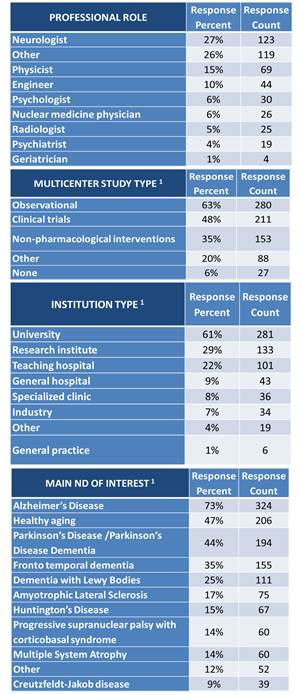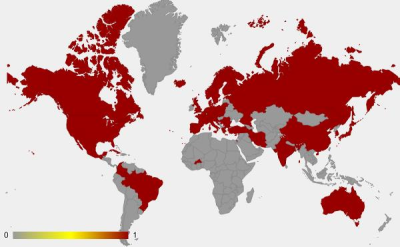3662
A survey of best practice guidelines to harmonize neuroimaging biomarkers for neurodegenerative diseases1Center for Mind/Brain Sciences, University of Trento, Rovereto, Italy, 2VU University Medical Center, Amsterdam, Netherlands, 3Centre for Medical Image Computing, University College London, London, United Kingdom, 4Sapienza University of Rome, Rome, Italy, 5University of Manchester, Manchester, United Kingdom, 6Psychiatry and Psychotherapy University Medical Center Hamburg Eppendorf, Hamburg, Germany, 7VU University Medical Center Amsterdam, Amsterdam, Netherlands, 8Lab Alzheimer’s Neuroimaging & Epidemiology, IRCCS Fatebenefratelli, Brescia, Italy, 9Memory Clinic and LANVIE Laboratory of Neuroimaging of Aging, University Hospitals and University of Geneva, Geneva, Switzerland
Synopsis
Current challenges in neurodegenerative diseases (ND): need for early and accurate markers for differential diagnosis, prognosis, progression tracking and intervention assessments.
Big-data neuroimaging studies might help addressing these challenges. However, large-sample neuroimaging data still lacks standardization (multi-vendor acquisition, analysis) and cross –validation (across markers, across large populations), in particular with state-of-the-art MRI hardware (≥32 head RF channel coils and powerful gradients).
Here we: i) evaluate current barriers perceived by the broad neuroimaging research/clinical/industry communities for the large-scale harmonization of MRI/PET-SPECT/EEG neuroimaging methods in the context of ND studies, and ii) propose actions that may help addressing these barriers.
INTRODUCTION:
The European Joint Programme on Neurodegenerative Disease Research (JPND) committed to our SRANED Working Group (http://www.sra ned.org/) the survey of the international community for identifying (1) current barriers for a harmonized use of MRI/PET/EEG biomarkers of neurodegenerative diseases and (2) community driven solutions to overcome them. This abstract focuses on the MRI findings.METHODS:
A 10minute survey (both multiple choice and open questions) was developed to gather information from relevant communities (neuroimaging consortia, industry, and more than 30 international researcher & medical associations). For each of the neuroimaging modalities the survey evaluated high-level barriers to participate in multicentric studies, biomarkers to be prioritized and current challenges for modality specific harmonization issues. Furthermore, suggestions were collected for overcoming these barriers.RESULTS:
459 participants completed the survey between February 1 and March 31, 2017 (MRI 53.6%, EEG 30.3%, and PET SPECT 16.1%). Participants represented a strong multidisciplinary community, dominated by research and academia while also including industry and clinical settings (Europe 75%, North and South America 20%, and Asia, Oceania and Africa 5%).
The community that responded to the survey identified the following main barriers, which were also common across the neuroimaging modalities evaluated: (1) lack of updated information and resources to effectively participate in multicenter neurodegenerative; (2) lack of guidelines for the harmonization of data acquisition using state-of-the-art equipment and protocols, biomarker extraction, and statistical modeling; (3) a general tendency of cost underestimation, in particular for software resources as well as for human resources with the relevant expertise, such as for the implementation of multicentric acquisition protocols and for data analyses; (4) lack of harmonized recommendations resulting from multiple multicentric harmonization efforts.
DISCUSSION:
To address these general barriers, we recommend that the JPND agenda includes the following action: establish a EU neuroimaging harmonization Working Group, considering MRI/PET-SPECT/EEG neuroimaging modalities, with advisors beyond EU, with commitments that include:
- Develop and maintain an open-access web-based forum that can serve as updated centralized repository of information relevant to multicenter studies in neurodegenerative diseases, generated by this group as well as from other initiatives. This resource should also enable a platform where people can exchange information and discuss new literature findings and recommendations.
- Develop and maintain updated consensus guidelines on the harmonization of neuroimaging MRI/PET-SPECT/EEG acquisition and analyses strategies in multicenter studies in neurodegenerative diseases. Where applicable, these guidelines should relate acquisition strategies with different target derived markers in the context of studying different neurodegenerative diseases using different experimental designs (cross-sectional versus longitudinal studies, observational versus treatment effect studies, etc.).
- Develop and maintain standardized registry for planning and budgeting multicenter neuroimaging projects. This registry should include the comprehensive list of recommendations of aspects that are agreed to be typically essential parts of any successful multicenter study. Such guidelines could be helpful to both researchers preparing grant applications and funding agencies when reviewing project proposals.
- Develop and maintain an updated registry of neuroimaging harmonization efforts that outlines key differences and common aspects of past/ongoing projects. Promote constructive synergies that help cross-reference recommendations and information from relevant multicentric neuroimaging biomarker harmonization projects.
- Promote periodic teaching activities through seminars/workshops/courses on topics relevant to the harmonized use of neuroimaging biomarkers in neurodegenerative diseases. This activity could be synchronized with periodic national and international conference meetings to offer relevant satellite events.
With specific regards to MRI modality, the JPND agenda may fund the harmonization of multivendor state-of-the-art acquisition protocols for high-spatial resolution anatomical MRI (including quantitative tissue mapping), microstructure and connectivity characterizations from diffusion MRI, as well as high-temporal resolution functional and perfusion MRI neuroimaging. There is a particular need for characterizing test-retest reproducibility errors given the interest in longitudinal studies. In addition, there is a need to develop automated quantitative quality assurance methods specific for the various methodologies in the context of multicenter studies. There is also a need to develop methods that are able to harmonize existing data already acquired without standardized protocols.
CONCLUSION:
To our knowledge, the SRANED survey represents the largest survey of the clinical neuroimaging community in the field of neurodegenerative diseases. The results provided make way for a strategic research agenda of future investments to exploit the potential of the MRI/PET/EEG biomarkers in large multicentric studies in neurodegenerative diseases.Acknowledgements
This work was supported by the European Joint Programme Neurodegenerative Disease Project, 2016 call: “Working Groups for Harmonisation and Alignment in Brain Imaging Methods for Neurodegeneration”. Our group thanks all participants of the survey as well as the leadership of the various associations who kindly accepted and facilitated the dissemination of the survey amongst its members.References
No reference found.Figures


